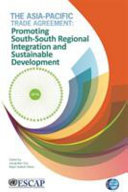
The Quran & Modern Science
by Dr Zakir Naik



Promoting South-South Regional Integration and Sustainable Development
Published on 2016
Joong-Wan Cho and Rajan Sudesh Ratna
International trade and investment have enabled many countries in the Asia-Pacific region to boost economic growth and have lifted millions out of poverty. As the Asia-Pacific region continues to thrive economically, trade and investment barriers are being dissolved and eliminated. As countries begin to depend on each other more, trade policy is gradually becoming a useful measure to achieve inclusive and sustainable development. Trade and investment are linked to the environment and social issues; hence, their impacts are also multi-dimensional. It has now been recognized that sustainable production and consumption are essential for sustainable development. Countries realize that they are not able to approach global and regional problems on their own and require cooperation, both at the level of government and business. As a result, the region has been active in concluding regional cooperation frameworks which routinely are centered on trade and investment. In the meantime, business has forged regional integration through the formation of regional value chains and production networks while governments have paved the way for the expansion of such production networks through the formation of regional trade agreements and economic partnerships. Thus, the Asia Pacific Trade Agreement (APTA), which is the oldest preferential trade agreement in the region with a large consumer base, can play an important role in filling this gap. Given a slow progress in the multilateral negotiations in the WTO, especially when the members have started questioning the utility of the negotiations after 15 years, and a lack of consensus on how to move forward, the regional trade agreements can play a vital role. Even if they pose a challenge to the multilateralism, selected liberalisation of trade and economy in present time can become a building block for future multilateral negotiations. One of the reasons for the surge in these preferential trade agreements is to make binding commitments on WTO-plus and WTO-beyond issues. While there are many agreements that exist in Asia and the Pacific, there is no such attempt to consolidate them in one umbrella framework. Understanding the benefits of the consolidation, one such initiative was started by ESCAP a few years back. The RECI initiate for market integration could well be facilitated by APTA; however, it cannot deliver unless it transforms itself in a new generation agreement. Regional integration and cooperation are also important to meet the 2030 agenda for sustainable development. Instead of wasting resources in discussing a new institutional framework, it would be more effective to use the existing framework and for the Asia-Pacific economies, the APTA provides an existing institutional platform. The cases discussed in this book prepare a ground for the future, and it is expected that all the stakeholders, member States of ESCAP, private sector as well as researchers would benefit from this publication on APTA: South-South Regional Integration and Sustainable Development.
Call No.
HF1021-1027.337.UNESCAP. 2016
ISBN
978-92-1-120719-4
Publisher
United Nations
Genres
Economic Integration and Development
Material Type
Document

by Dr Zakir Naik
No image
by Andrew Elek
No image
by Mohan Malik